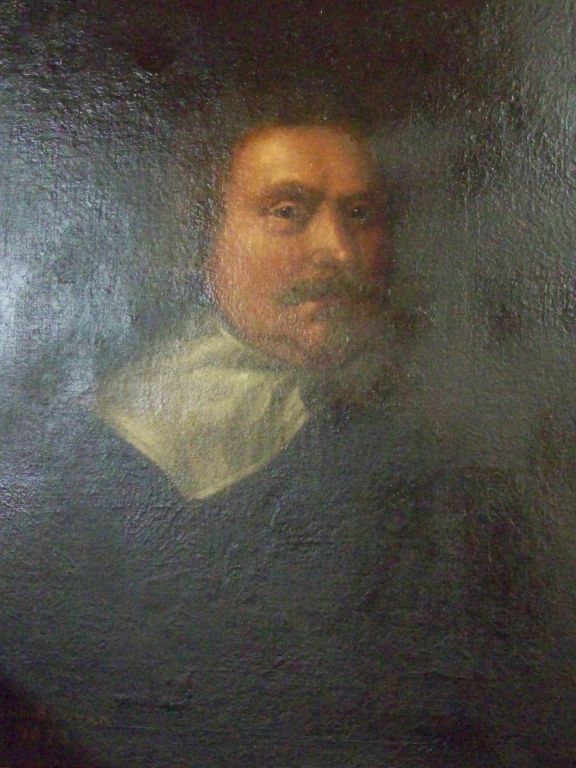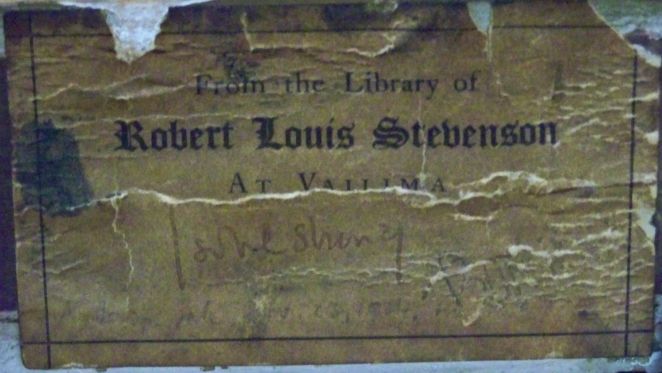
[SOLD]
RARE 1673 PORTRAIT OF JOHN BUNYAN
(The Thomas and Robert Louis Stevenson-Arthur Plimpton Collection Bunyan) Pre-dates the Sadler Bunyan of 1684.

NOTE ON THE FRONTISPIECE (This portrait) by VERA BRITTAIN
"The portrait of John Bunyan which appears at the beginning
of the book (In the Steps of John Bunyan) was painted by an unknown
artist in 1673, the year after Bunyan's long imprisonment ended. It
came into the possession of Robert Louis Stevenson's father, and was
greatly valued by both him and his son. When the younger Stevenson
settled in Samoa, he had the picture sent out to him. (Stevenson wrote
a nice introduction to Pilgrim's Progress)

After Robert Louis Stevenson's death, the portrait was pur-
chased by the late Mr. George A. Plimpton of New York, and
became part of the Plimpton Collection. Owing to its American
ownership, it has not previously been used by a British biographer
of Bunyan. It is here reproduced by the courtesy of Mrs. George
A. Plimpton and the Frick Art Reference Library, Columbia
University, New York. I am greatly indebted for help given me in
tracing it to Mr. Francis T. P. Plimpton, son of Mr. George A.
Plimpton, and to the Macmillan Company of New York.
A copy of this portrait was made in 1930 for Mr. George A. Plimpton
and presented by him to the late Dr. Frank Mott Harrison. This copy
now
resides in the John Bunyan Library, which Dr. Harrison gave to
Bedford a few years before his death in 1945.
The only contemporary portraits of John Bunyan mostly
familiar to British readers are the pencil sketch by Robert White,
bequeathed by the Rev. Clayton M. Crackerode to the British
Museum in 1799; the portrait made in 1684 by Thomas Sadler,
son of John Sadler, Master of Magdalene College, Cambridge,
which hangs in the National Portrait Gallery, Room VII (No.
1311); and the engraving by Sturt, prefixed to the first folio
edition of Bunyan's works in 1692 and taken from a painting which
has not been re-discovered.
Sadler's picture may have correctly depicted the external man,
but it seems to be even further than White's from conveying his
spirit. The crude Puritan peasant of the National Gallery portrait
might have produced The Life and Death of Mr. Badman; he
could not possibly have written Grace Abounding or The Pilgrim's
Progress.
I have chosen the portrait that belonged to Robert Louis
Stevenson because it seems to me to capture the essential John
Bunyan. The artist painted the date clearly on his picture, and
though he did not leave us his name, it is obvious that he followed
the Rembrandt tradition and understood his craft.
He shows us a Bunyan tense and puffy of countenance, as he
would have appeared after long confinement, with hair cut short,
and deep lines under the eyes. Those eyes, at times, had looked on
terrible things.
John Bunyan went into Bedford County Gaol a hot-headed
young rebel just thirty-two years old. He came out a mature and
experienced man of forty-three, in whose presence other prisoners
had died. On the face of this portrait his story is written. It speaks
to us of the suffering and fortitude which unite through all time
the men and women who are moved by the power of the spirit".
Provenance:
Robert Louis Stevenson's father (Thomas Stevenson: 1818-1887) to Robert
Louis Stevenson (with the Stevenson ownership label affixed to the same
frame from Stevenson's ownership. Sold after Stevenson's death (at the
Robert Louis Stevenson Sale conducted by Anderson Auction Co., Nov.
23-25 in 1914. Item #447, pg. 75) and purchased by George A. Plimpton
(1855-1936) becoming part of the large Plimpton Collection of Portraits
in whose family this painting has remained through today. (Plimpton
put together a collection of contemporary portraits of English authors
that at the time was unequalled even by the National Portrait Gallery
in London. These paintings hung on the wall of the President's House
at Amherst College during the administration of his son, Dr. Calvin
Hastings Plimpton [1960-1971]*. Many of his valuable collections were
donated to various institutions) Although primarily hung in the family
homes in New York, Cape Cod, or the Berkshires it has also been exhibited
at Harvard University (where the canvas was affixed to the current backing
material as was done a number of years ago) and in the Amherst College
President's house during Calvin H. Plimpton's tenure as head of that
college from 1960-1972. Some cleaning of the portrait in the last 50
years. Exhibited at the American Tract Society in 1928 as well. As with
Sadler's portrait of Bunyan in the National Gallery, provenance can
be traced to only the early 1800's.
An early, rare portrait of Bunyan, just out of the gaol, (pre-dating
the Sadler 1684 portrait in the National Gallery), which has been in
but two family collections for the last 150 years. Further research
may reveal more interesting details. A unique and important literary
artifact.
Among George Plimpton's collections are:
The Plimpton library, which in part had been placed on deposit at Columbia
University in 1932, was formally presented in 1936 shortly before the
donor's death. The collection of more than sixteen thousand volumes
was formed by Plimpton, who served as a board member of Ginn & Company,
the textbook publisher, to show the development of "our tools of
learning." He stated his notable purpose in the preface to his
The Education of Shakespeare as "the privilege to get together
the manuscripts and books which are more or less responsible for our
present civilization, because they are the books from which the youth
of many centuries have received their education." In general, the
Plimpton Library may be described as an assemblage of notable treatises
on the liberal arts, particularly grammar, rhetoric, arithmetic, algebra,
geometry, geography, astronomy and handwriting. Represented in the Library
are the forms of knowledge from the most rudimentary, the hornbook,
to the most sublime heights reached in the writings of Aristotle, Donatus,
Cicero, Boethius, Euclid, Ptolemy, Pliny and Petrus Lombardus. It is
hardly surprising that one of the earliest items in the collection may
be the most remarkable, a cuneiform clay tablet on which is written
in Old Babylonian script, between 1900 and 1600 B.C., a mathematical
text resembling the Pythagorean numbers.
The 317 medieval and renaissance manuscripts collected by George Plimpton
form the largest such group in the Rare Book and Manuscript Library.
Among the manuscripts of texts by classical authors, the antiphonals,
the early grammars, the mathematical and philosophical treatises, and
the writings of the church fathers, there is a monumental manuscript
of Bartholomaeus Anglicus, the De Proprietatibus Rerum in John of Trevisa's
English translation of 1398, which was produced in England, ca. 1440;
this manuscript was most likely the copy used by Wynkyn de Worde in
1495 for the first printed edition. There is also a manuscript leaf
from Chaucer's The Canterbury Tales and a complete manuscript of the
author's A Treatise on the Astrolabe, both written in England in the
fifteenth century.
Association books abound in the Plimpton library, for the collector
was interested in why and how books were used, and who used them. Volumes
once owned by notable humanists and scientists include the following:
Roger Ascham's copy of The Abridgement of the Boke of Assises, 1555;
Christopher Wren's copy of Catechesis ecclesiarum, 1609; Sir Thomas
More's copy of Euclid's Elements, 1516; Isaac Newton's copy of Vincent
Wing's Harmonium coeleste, 1651, and Erasmus's copy of the 1502 edition
of Herodotus. Of paramount interest is the 1517 edition of Homer, published
by Aldus, inscribed by Philip Melancthon to Martin Luther, and with
Melancthon's notes throughout. Among the nearly six hundred copybooks
and handwriting manuals is one of the two recorded copies of the first
edition of A Boke Containing Divers Sortes of Hands, 1570, by John De
Beauchesne and John Baildon, the first handwriting book published in
England. Plimpton's library did, indeed, represent the labor of a collector
and the experience of a career, the blending of a vocation as publisher
and an avocation as bibliophile and author.
*pg 11, introduction to: A Collectors Recollections: George Arthur Plimpton.
NY: Columbia University Libraries, 1993.
